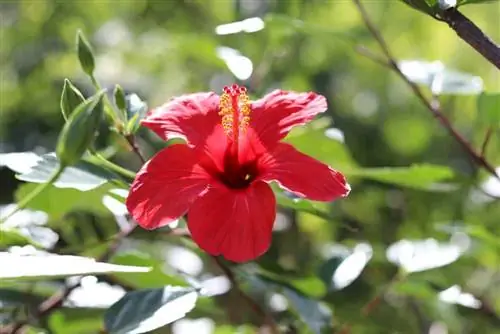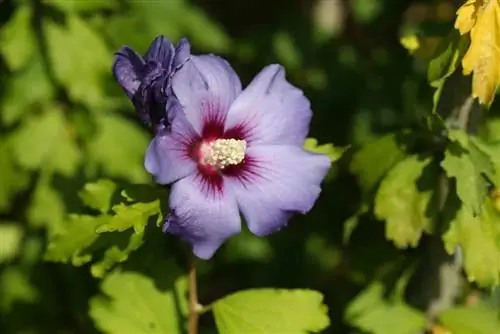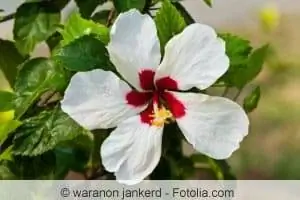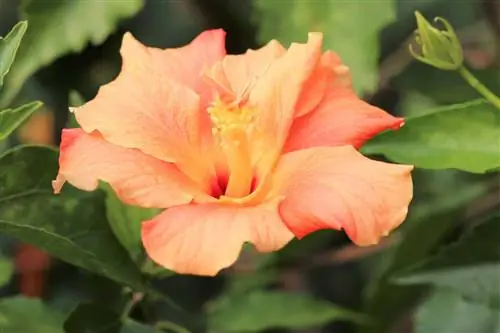- Author admin [email protected].
- Public 2023-12-17 03:39.
- Last modified 2025-01-24 12:45.
What's exciting about the shrub marshmallow for hobby gardeners is that this plant has its main flowering period when most other Central European trees have already finished flowering and are predominantly lush green. This uniqueness and the exotic-looking flowers make the marshmallow a real eye-catcher in the garden, which does not have to fear any competition, especially in midsummer.
Location and possible uses
The marshmallow appreciates both full sun and partial sun, warm locations, which should, however, be protected. If the plant is in a location that is too shady, both flower development and the plant's overall growth will be significantly sparser than in an ideal location. This plant also appreciates soil that is both nutritious and permeable. Hobby gardeners must definitely avoid severe drought with this plant. The shrub marshmallow is very suitable for a solitary position, but the plant also looks very good when planted in groups or as a flowering hedge. In addition to the bush, this plant can also be found commercially in the form of an ornamental tree in three different trunk heights. In the form of the foot trunk, the plant has a trunk height of only around 50 cm, the half trunk is already 100 cm high and as a standard the plant can reach 200 cm. This makes the hobby gardener very flexible in designing his garden with this plant.
The marshmallow appreciates:
- fully sunny and partly sunny, warm locations
- a nutritious and well-drained soil
- regular and intensive water supply
Slow growth
If you want to grow a solitary plant from a potted plant, you have to be patient for several years before there is significant growth. This is due to the so-called growth regulators that the plant has and would no longer be possible without cultivating the pot plant. Only after a few years, when the so-called compression effect is reduced, does normal growth resume, without the effect of the inbred growth regulators.
Care
The shrub marshmallow is generally easy to care for. The essential care requirements of the plant are met with the addition of compost or fertilizer in spring and intensive watering in times of severe drought. The plant must be kept well moist, especially in the warm season, as it must not dry out. However, it is important to avoid waterlogging. If the plant is kept as a container plant, the excess water must be removed from the planters regularly, otherwise there is a risk that the root ball will rot. The plant must also be kept moist in the winter months. The plant is
- easy care
- very thirsty, especially in summer bloom
- sensitive to waterlogging
Cutting
The marshmallow must be cut before the leaves emerge in spring because, like almost all summer late bloomers, it blooms on the new shoot. Cutting back strengthens the shoots. That's why a strong pruning in spring is ideal. To ensure that the shrub marshmallow has a compact growth habit, when pruning you can make sure to remove all new side shoots from the previous year that come off the main branches and main trunks. Alternatively, consistent pruning around the bush by around a third can also be a solution. If it is a free-growing shrub marshmallow, it can be heavily thinned out for natural growth and the shoots can also be shortened.
The best time for pruning is spring, before the leaves emerge. Don't worry, by the way: Even if the marshmallow looks unattractive immediately after it has been heavily cut, it will regain its old beauty the following summer. This is also reflected in the fact that the number of flowers may decrease due to the reduction of shoots, but the individual flowers increase in size. A very vigorous pruning should be done every two to three years so that the plant does not age and continues to grow bushy and multi-shooted. A marshmallow only produces its flowers on fresh, annual shoots. If the marshmallow is never cut back, the flowers only form at the end of the shoots, and the flowers are also smaller than when the marshmallows are cut back. In general, pruning promotes the vitality and long lifespan of the plant.
Tip:
The radical pruning should only be done on a vital plant, as a weakened plant may die after this radical pruning.
The marshmallow requires:
- a regular, moderate cut for intensive flowering every spring
- a strong pruning every two to three years for long life and good growth
Wintering
As an outdoor plant, the marshmallow is a hardy garden tree. Not least because the plant sprouts relatively late in spring, it is even protected from late frosts and these do not cause any damage to the plant. The marshmallow therefore does not need any specific protection in winter. If the plant is kept in a pot, it is recommended to overwinter in a cool and bright room with a maximum room temperature of 10 to 15 °C. A marshmallow kept as a houseplant all year round can also be kept in a warmer room in winter. In this case, the plant also flowers during the winter months, but then requires a lot of water.
Fertilization & Watering
The marshmallow should be fertilized once or twice a week from May to August with a commercial flowering plant fertilizer. Due to its intensive and long flowering, the plant requires a lot of nutrients and also a lot of water. The hardy plant, which is planted freely, is fertilized twice a year - once in March/April, once in May/June - and always watered when it is dry.
In summer the marshmallow is very thirsty and requires large amounts of water. If the plant dries out, it reacts immediately by dropping buds and flowers.
Flowering & Repotting
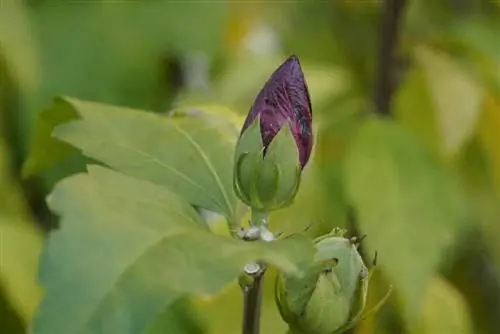
The flowering period of the marshmallow is from July to October, with the first buds opening relatively late, compared to other plants, at the end of July. Then the marshmallow blooms until the end of September and if the summer is very warm, the plant can bloom well into October. The plant produces its flowers on the annual tree.
If the marshmallow is kept as a container plant, it should always be repotted in March when the ball of the plant is well rooted overall. The ideal substrate here is fresh and nutrient-rich potting soil.
Pests
Especially in spring and summer - during the intensive and energy-sapping flowering phase - the shrub marshmallow is particularly prone to being attacked by aphids, but also by spider mites and whiteflies as well as mealybugs. That's why regular and thorough checks are necessary, especially at this time, so that the pests can be combated immediately with commercially available pesticides and do not get out of hand and thus destroy the plant.
Frequently asked questions
My marshmallow is dropping buds. What to do?
If the marshmallow drops its buds, it is usually because it is kept too dry because it saves energy. Intensive watering is essential, especially during the flowering period.
How do I get more flowers on my marshmallow?
Many types of hibiscus cannot tolerate frost and therefore have to stay warm over the winter. The winter-hardy Hibiscus syriacus is different, as it can survive even shorter periods of sub-zero temperatures down to -20 °C without being damaged. This property makes it possible to stand outdoors all year round and has given the Hibscus syriacus the common names shrub marshmallow and garden hibiscus.
What you should know about Hibiscus syriacus soon
Care
- Like every hibiscus, the Hibscus syriacus also needs a lot of moisture in order to develop splendidly.
- A drought lasting several days usually results in bud drop and yellow leaves.
- Similar to clematis, low underplanting is recommended for marshmallows to protect the soil from drying out too quickly.
- Waterlogging must be avoided despite frequent watering. Therefore, the soil should be rich in humus, but also permeable.
- A small amount of lime is still tolerated. Annual compost additions provide the necessary nutrients.
- Additional fertilization should be carried out over the summer months, especially when kept in containers.
- Liquid fertilizer every 2-3 weeks or the occasional incorporation of horn shavings is suitable.
- Plants that are well supplied with nutrients are usually not so easily susceptible to aphids, which like to settle on the young shoots of hibiscus plants.
- A light infestation can usually be remedied by spraying on soap solution, otherwise pesticides can help.
- Mealybugs and spider mites rarely settle on hibiscus.
Plants
- If several plants are placed next to each other, a minimum distance of 50 cm is required.
- The Hibiscus syriacus can only tolerate transplanting to a limited extent, which is why it should be done very gently.
- The fleshy, deep roots must not be damaged under any circumstances.
- The ideal time for transplanting is late spring.
- The location should be as sunny as possible. Partial shade is still possible, but fewer flowers will probably develop there.
- Belonging to the winter-hardy varieties, the marshmallow should be protected with fir branches and a layer of mulch made of leaves for at least the first two years.
Cutting
- It is recommended that the garden hibiscus be pruned annually in spring. It can be done vigorously, which positively supports the new growth.
- In order to maintain a compact growth habit, several shoots from the previous year that are on the thick main branches can be completely cut off.
- This thinning allows the remaining shoots to receive the much-needed sunlight.
- The remaining branches should ideally be shortened by a third.
- Slightly different rules apply to high tribes. Here the bare trunk and the round crown are in the foreground.
- All shoots that grow out of the trunk are best removed as soon as possible throughout the year.
- When cutting, the spherical shape must be retained. Too dense growth is prevented by completely cutting some shoots.
Conclusion
With the Hibiscus syriacus, the rose marshmallow has become a permanent, year-round part of the garden. It is suitable for planting on the bed as well as in a bucket. When caring for your skin, you should not lose sight of optimal water and nutrient supply.


